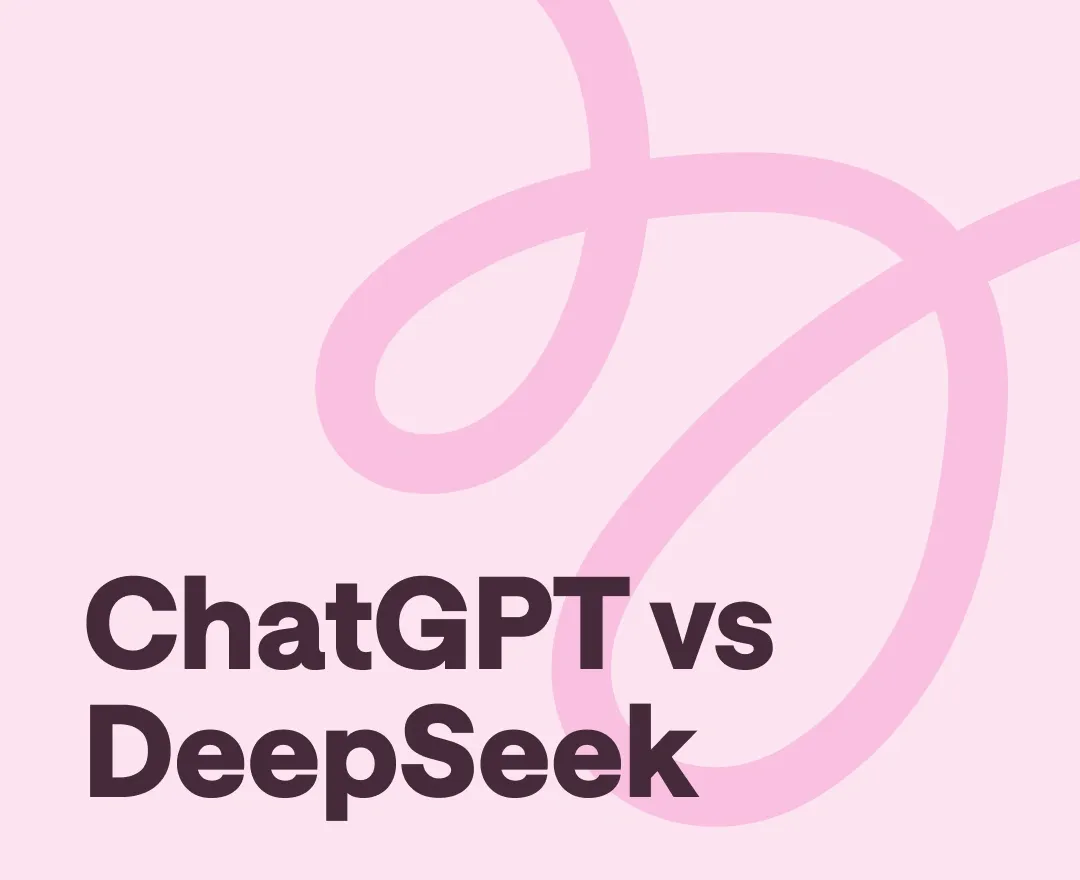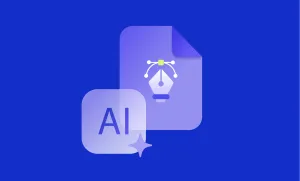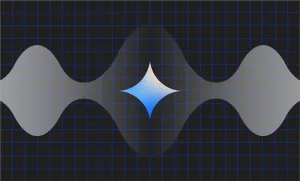Ladies and gentlemen… welcome to the ultimate AI match of the year!
In the red corner, ChatGPT: trained by OpenAI, polished, powerful, and battle-tested.
In the blue corner, DeepSeek: lean, lightning-fast, and making waves with cost-efficient brainpower.
The real question is: which one actually helps you work better?
We put them to the test across all major creator workflows: writing scripts, summarizing docs, and making content.
Key Findings
- ChatGPT excels in speed and clean delivery. DeepSeek takes longer but creates more immersive, layered narratives, especially in long-form formats.
- ChatGPT adapts tone of voice naturally across platforms, whereas DeepSeek favors structured, neutral output.
- DeepSeek was more accurate in factual and literary tasks, sticking closer to source material, and avoiding hallucinations. ChatGPT, while more readable, occasionally introduced invented details.
- ChatGPT outperforms in multimodal and real-time tasks. From image generation to live news searches and file uploads, ChatGPT supports a broader range of content formats and updates faster.
- DeepSeek has no user rate limits, while ChatGPT’s free tier restricts usage.
Table of Contents
– What is ChatGPT?
– What is DeepSeek?
– ChatGPT vs DeepSeek: Basic Differences
– ChatGPT vs DeepSeek: Use Case Comparisons
– Brainstorming
– Writing a Podcast Script
– Who is Better at Creative Writing?
– File Handling and Analysis
– Image Interpretation
– Social Media Content Creation
– Real-Time Search
– Content Repurposing
– Who Summarizes Better?
– Solving Math and Physics with AI
Which Model Excels at the Essentials?
– ChatGPT vs DeepSeek: Pros & Cons
– The Final Verdict
What is ChatGPT?
ChatGPT is a generative AI chatbot developed by OpenAI, a research organization focused on advancing AI technology. OpenAI was founded in 2015 by a group of prominent tech figures, including Elon Musk, Sam Altman, Greg Brockman, Ilya Sutskever, Wojciech Zaremba, and others.
When did ChatGPT release?
ChatGPT was officially released to the public on November 30, 2022, and quickly gained widespread attention for its ability to generate human-like text responses.
How many people use ChatGPT?
ChatGPT has become the fastest-growing consumer software application in history, reaching 100 million users within two months. Its success spurred the development of competing products like Google's Gemini and Anthropic's Claude, cementing its place as a transformative tool in the AI landscape.
Now, the chatbot boasts nearly 400 million weekly active users and over 122 million daily users.
ChatGPT Models
ChatGPT Pricing
Here’s an overview of ChatGPT’s subscription options and what each includes:
- Free ($0/month): Basic access with limited AI features, web search, file uploads, image and voice tools, and code help.
- Plus ($20/month): Everything in Free, plus faster and smarter AI, more usage, full file uploads, advanced voice/video, web research, and better models.
- Pro ($200/month): All Plus features with unlimited access to every model, extended research, video generation, and special AI agents.
- Team ($25/user/month, billed yearly): Pro-level features for teams with shared workspace, admin controls, and enhanced privacy.
- Enterprise (custom pricing): Everything in Team plus extra security, custom setups, priority support, and AI consulting.
What is DeepSeek?
DeepSeek is a Chinese artificial intelligence company specializing in LLMs. Founded in July 2023 by Liang Wenfeng, (co-founder of the hedge fund High-Flyer), the company is headquartered in Hangzhou and has quickly risen to prominence in the AI industry.
How does DeepSeek work?
DeepSeek’s models, such as DeepSeek-R1 and DeepSeek-V3, are known for their efficiency, offering performance comparable to that of OpenAI’s GPT-4o but at a fraction of the cost. The company’s innovative use of techniques like Mixture of Experts (MoE) and multi-head latent attention (MLA) has allowed it to train models for just $6 million, far less than the $100 million reportedly spent on GPT-4.
One of DeepSeek’s most notable achievements is its ability to compete with established AI giants despite operating under U.S. chip export restrictions. By optimizing its training processes and using weaker AI chips, the company has demonstrated remarkable cost efficiency.
What's DeepSeek's latest model?
In January 2025, DeepSeek launched its DeepThink-R1 chatbot (along with the regular DeepSeek chatbot), which quickly surpassed ChatGPT as the most downloaded free app on the U.S. iOS App Store. This success sent shockwaves through the industry, leading to a significant drop in Nvidia’s stock price as investors questioned the future demand for high-end AI hardware.
Is DeepSeek available in US?
As of June 2025, DeepSeek is available for public use in the US, but has been restricted on federal and state government devices due to national security and data privacy concerns. The restrictions stem from concerns that DeepSeek, developed in China, could potentially expose sensitive data or be subject to Chinese government surveillance laws, raising national security and privacy risks for U.S. institutions.
How many people use DeepSeek?
As of latest, DeepSeek boasts 96.88 million monthly active users globally, with China, India, and Indonesia being the major markets.
DeepSeek Models and Pricing
Let’s have a look at a simple breakdown of DeepSeek’s models:
- DeepSeek-V3: Ideal for everyday tasks, available for free.
- DeepThink-R1: Best for coding and reasoning, available for free.
There are fees for API access, but they are quite low compared to those of ChatGPT.
ChatGPT vs DeepSeek: Basic Differences
It’s worth understanding what each chatbot is actually designed to do. While both ChatGPT and DeepSeek are built on LLMs, their strengths reflect different goals, priorities, and user bases.
Below we have gathered a list of the main capabilities of each, as ‘written on paper’.
1. Natural Language Understanding and Conversation
ChatGPT excels at maintaining natural, context-aware conversations across many topics. Adapts tone and style to fit the user's needs.
DeepSeek is also capable of multi-turn conversations, especially strong in technical topics like science and engineering.
2. Writing and Content Creation
ChatGPT is versatile across creative and formal writing, handles essays, blogs, dialogue, and even poetry.
DeepSeek, on the other hand, is especially strong in technical writing such as documentation and summaries; creative writing is supported too and when given the right prompts, it generates clear, concise, and well-structured content that often mirrors the tone and logic of expert human writers.
3. Programming and Technical Support
ChatGPT offers wide-ranging support for code generation, debugging, and explaining concepts across many languages.
DeepSeek is especially strong in math-heavy programming and algorithmic explanations; it supports multiple languages including Python and C++. DeepSeek also supports compiler-integrated verification (e.g., checks code against unit tests).
4. Reasoning and Problem-Solving
ChatGPT handles math and logic tasks with clear, step-by-step reasoning; good for general problem solving.
DeepSeek also excels in structured reasoning, particularly for math, logic, and scientific content; highly accurate and systematic.
5. Analyzing Data, Files, and Documents
ChatGPT can read and analyze PDFs, Word, PowerPoint, images, and text files, but full file upload features require a paid Plus or Pro subscription.
DeepSeek supports PDFs, Word, Excel, PowerPoint, images, and text files, offering detailed summaries and analysis, with free local use or paid API access.
6. Generating Media
ChatGPT generates images using DALL·E within the chat.
DeepSeek is limited to text-based input only and does not support image or video generation.
7. Language Support
ChatGPT offers broad multilingual support (100+ languages), including nuanced translations and cultural adaptations.
DeepSeek is strong in English/Chinese; other languages are secondary. Focused on technical/bilingual accuracy.
Note: While both models can access the internet for queries that trigger searches, they may lack complete awareness of events, research, or trends after their knowledge cutoff dates (July 2024 for DeepSeek and April 2024 for GPT-4o).
ChatGPT vs DeepSeek: Use Case Comparisons
On paper, AI models sound impressive: fluent in dozens of languages, experts at coding, masters of logic. But most people don’t use these tools to admire their specs. We use them when we’re stuck, curious, busy, or just trying to get something done a little faster and a little better.
This section looks at how ChatGPT and DeepSeek actually perform when given the same task. From writing and brainstorming to coding and problem-solving, we’ll walk you through real prompts that reflect everyday needs. The goal isn’t to crown a winner, but to understand how each model thinks, responds, and helps in its own way. Because at the end of the day, it’s about who helps you get where you’re going.
Note: When testing both chatbots, we have mainly used their reasoning modes.
1. Brainstorming
We asked both ChatGPT and DeepSeek to brainstorm 10 original podcast ideas, an open-ended task aimed at testing creative range, conceptual clarity, and genre diversity.
ChatGPT’s response leaned into variety and accessibility, offering podcast ideas that span history, wellness, business, fiction, and science. Its titles were snappy (“Snackable History,” “Two Truths and a Legend”) and the formats were cleanly explained. It showed strength in tone adaptation, using casual, listener-friendly phrasing and clever branding. However, some ideas leaned toward familiar tropes, and while fun, they occasionally lacked depth in structural uniqueness or conceptual layering.
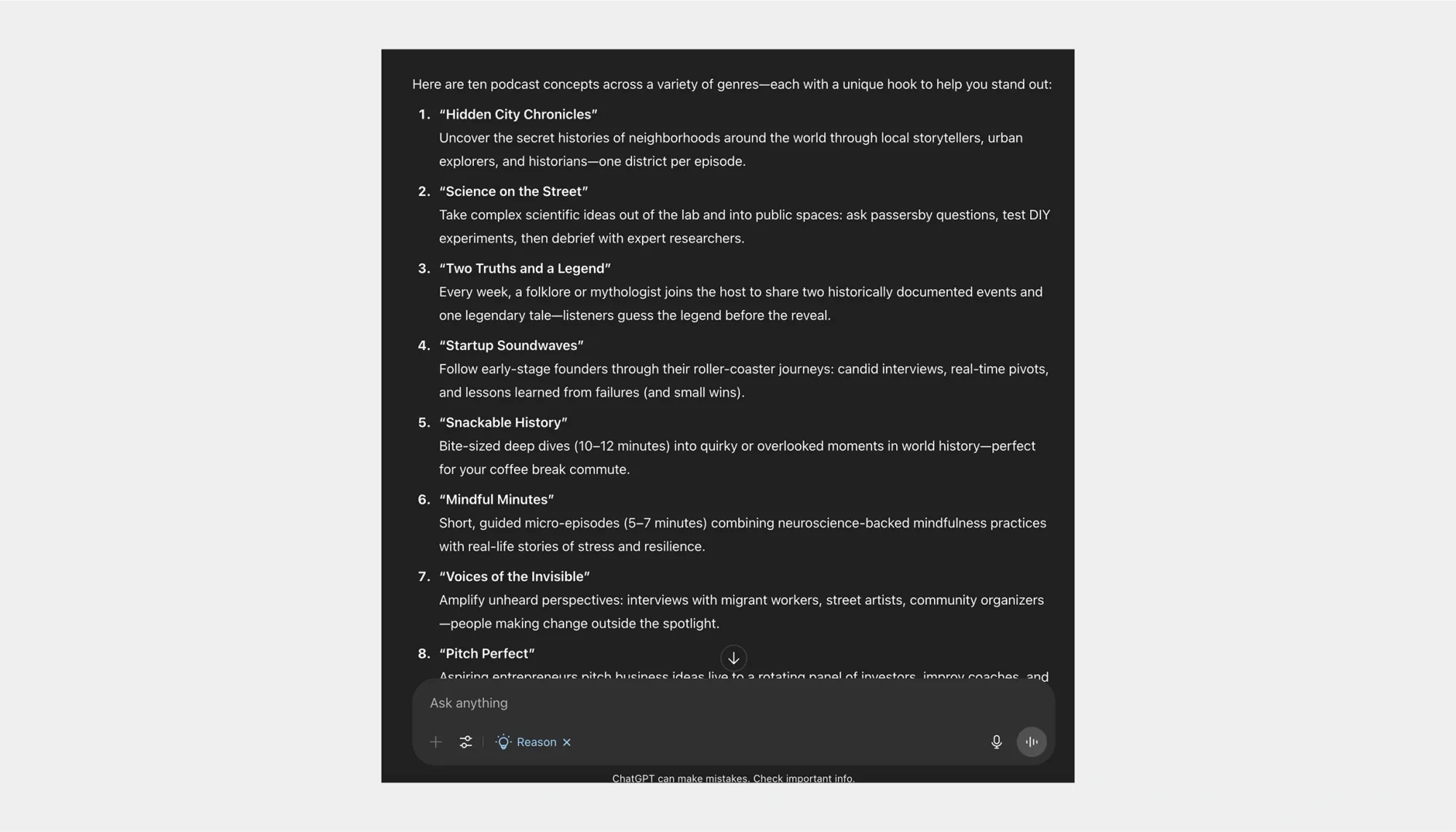
DeepSeek’s list, on the other hand, delivered more intricate and research-driven concepts. Its suggestions often came with detailed hooks, potential formats, and even segment ideas (e.g., “Creative Chain” in Constraint Breeds Creativity). It offered stronger thematic cohesion, deeper framing, and intellectual appeal, particularly for documentary, historical, and science-based formats. The ideas were also more exploratory and immersive, with some showing real potential for long-form or narrative production.
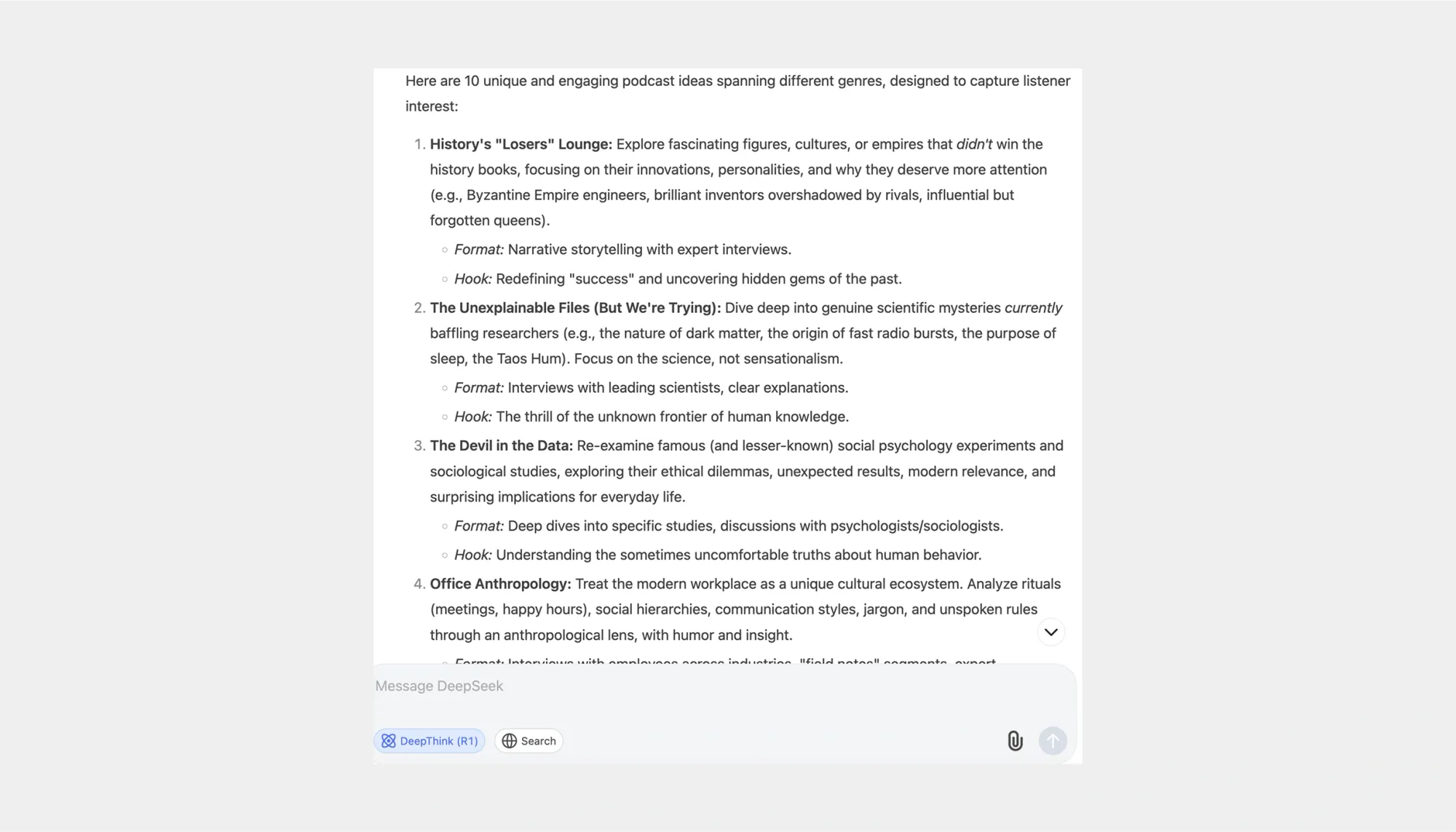
Who wins?
Both models are capable brainstormers, but with slightly different styles. In our task, ChatGPT excelled in approachability and title flair, while DeepSeek favoured deeper structure and conceptual nuance.
If you’re looking for broad appeal and fast ideation, ChatGPT may feel more instantly polished. But if you want thoughtful depth and niche originality, DeepSeek may be more rewarding.
2. Writing a Podcast Script
To test their ability to craft compelling audio storytelling, we asked both models to write a podcast script for an episode of Voices of the Invisible (a topic chosen from the above lists), a concept focused on elevating unheard perspectives like those of migrant workers, street artists, and grassroots organizers through interviews. The challenge: write a script that feels human, empathetic, and structured enough for a host-led, interview-driven show.
ChatGPT delivered a polished, structured episode featuring three distinct voices: a migrant worker, a street artist, and a community organizer. The format felt well-balanced and digestible, using clear segment transitions and ambient sound cues to guide the listener through each story. Its tone was warm and professional, and while the dialogue was emotionally sensitive, it sometimes leaned toward polished generalities over deep specificity.
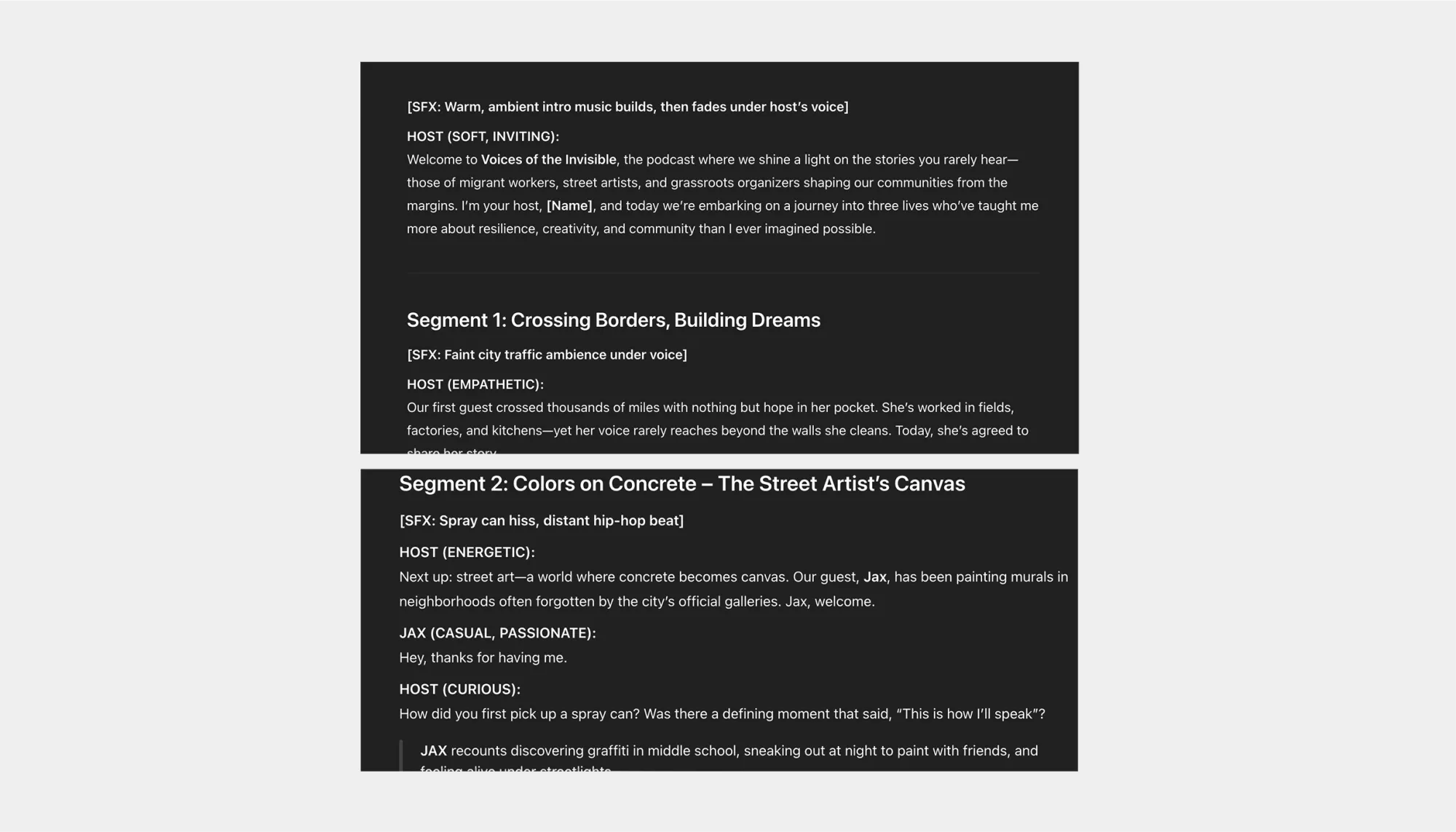
The guests’ responses, while coherent, lacked the nuanced detail or personality quirks that bring real voices to life. They were not represented in first person and were the chatbot’s generic suggestion as to what the guests should talk about.
Overall, ChatGPT’s version was versatile and audience-friendly: ideal for broader appeal and episodic variety.
DeepSeek, on the other hand, chose to focus the entire episode on a single guest: Luna, a domestic worker from the Philippines. This allowed for a much deeper emotional arc, from her migration story to exploitation and eventual empowerment through community. The dialogue was vivid and authentic, rich with cultural and sensory details.
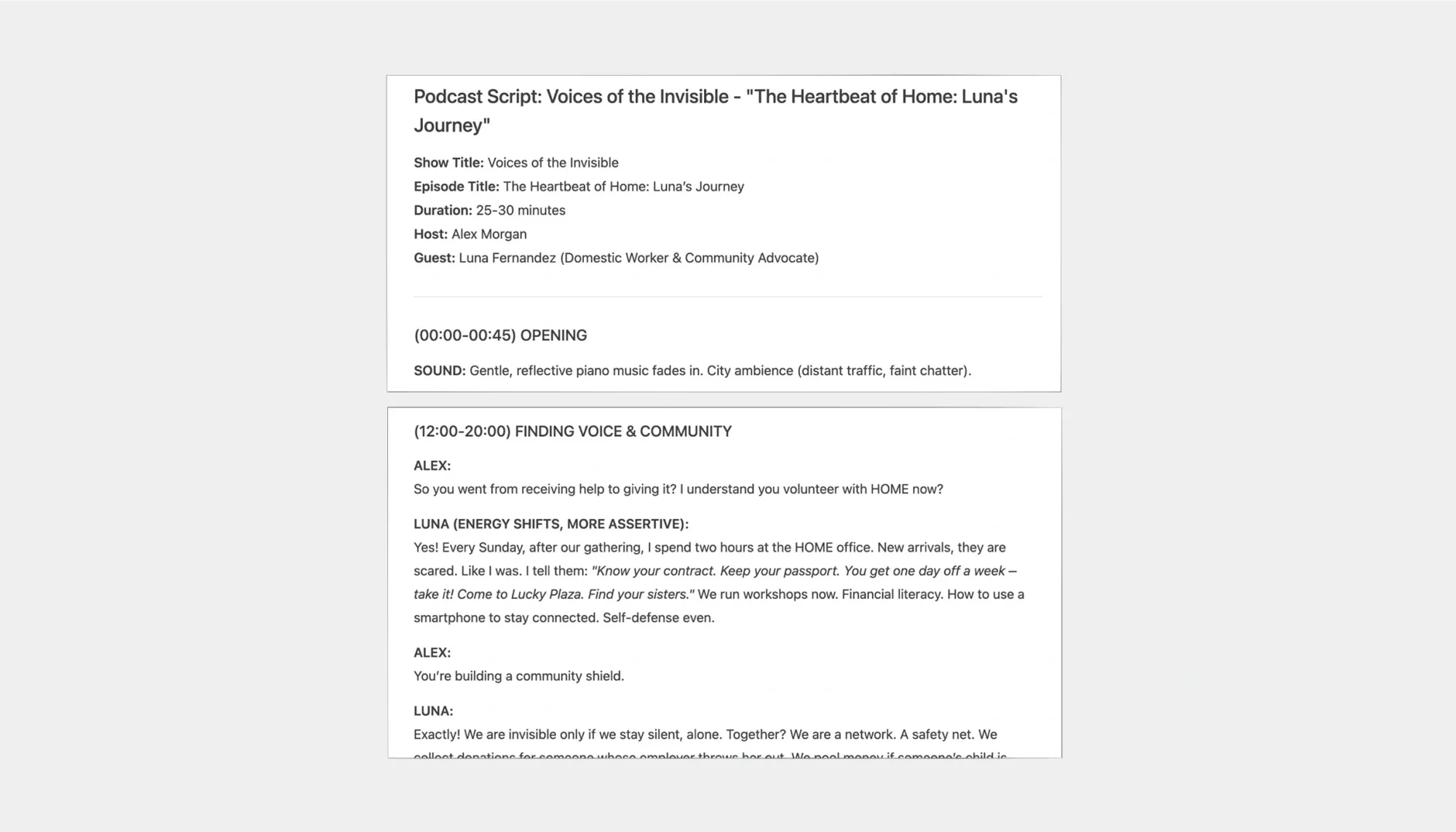
Luna’s pauses, emotional shifts, and specific anecdotes made her feel fully human, while the host’s gentle prompting built trust and space for reflection. Sound design was used sparingly but effectively to support mood and transitions. DeepSeek’s script felt like a mini-documentary: immersive, intimate, and emotionally resonant.
Who wins?
Both scripts succeed in different ways. ChatGPT offered breadth, clean structure, and polished storytelling fit for mainstream podcast formats.
DeepSeek delivered more emotional depth, realism, and narrative cohesion by zooming in on one subject.
However, DeepSeek definitely gets the win here for delivering a raw, heartfelt narrative with journalistic weight.
3. Who is Better at Creative Writing?
To test their creative instincts, we gave both chatbots the same writing prompt: a 300-word essay titled “A Walk by the Ocean.” It’s the kind of topic that leaves plenty of room for interpretation: tone, imagery, emotion, even structure.
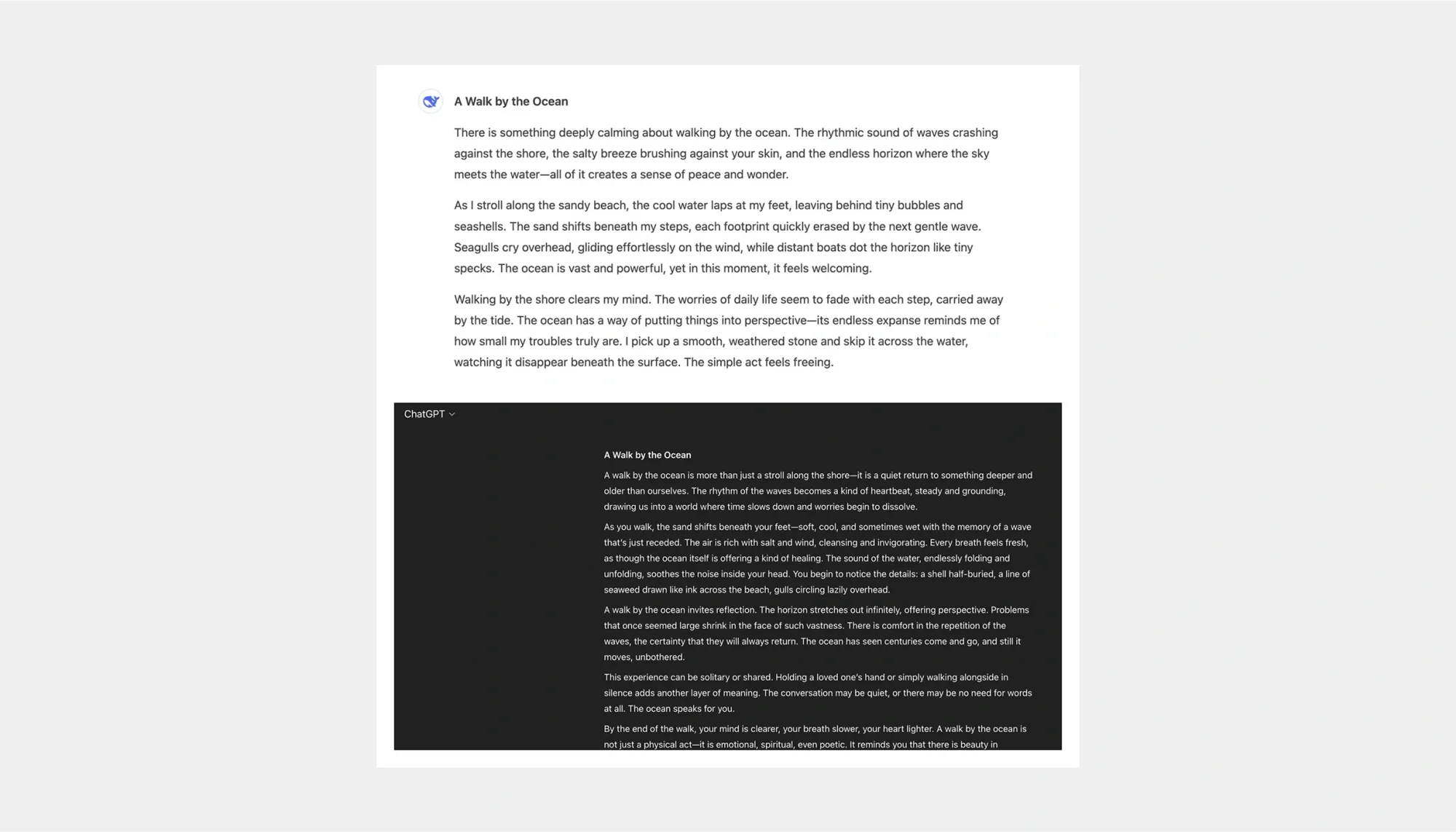
Who wins?
Genuinely impressive. Both ChatGPT and DeepSeek captured the mood beautifully, painting scenes that felt calm, reflective, and vivid. The writing had rhythm. It had atmosphere. Each AI approached the prompt with its own voice, but both managed to tap into the feeling behind the words - that quiet, expansive sense of walking beside something larger than yourself.
As for which of these texts deserves the win, that ultimately comes down to personal preference.
And to be honest, at this point, it’s quite intimidating how good at creative tasks AI has become - the real-world writers need to work hard to give something of true value and authenticity nowadays.
Note: Both tools were not too conscious of keeping the exact word count but they came close - with ChatGPT delivering 288 words and DeepSeek coming with 275 words.
4. File Handling and Analysis
When handed a dense, 14-page academic paper on Dylan Thomas’ poetic style, both ChatGPT and DeepSeek rose to the challenge but in noticeably different ways.
ChatGPT delivered a highly organized summary that read almost like a table of contents brought to life. It broke the paper into thematic chunks (Abstract, Context, Development of Style, etc.) and offered digestible, well-phrased highlights for each. The language was clear and accessible, striking a balance between academic and conversational. Its conclusion neatly tied everything together, providing not just what the paper said but what it meant.
DeepSeek, meanwhile, leaned more into academic framing and textual analysis. It offered deeper critical insights, quoting more directly from the source and discussing the historical and literary context in sharper detail. It mirrored the voice of an actual literary critic, even pointing out anomalies in the paper (like off-topic citations in the reference list). Its structure was less segmented than ChatGPT’s but arguably richer in interpretive depth, ideal for someone looking to study the material more seriously.
Who wins?
It depends.
If you’re after a clear, structured summary with accessible language and strong readability, ChatGPT feels more user-friendly.
If you want a deep-dive analysis with scholarly tone and attention to textual fidelity, DeepSeek brings a level of rigour that feels closer to how an academic might annotate the paper.
5. Image Interpretation
To see how well ChatGPT and DeepSeek handle visual inputs, we gave them a diagram on renewable energy, the kind you'd find in a textbook or classroom presentation. The goal was simple: can they understand and explain what’s going on in the image?
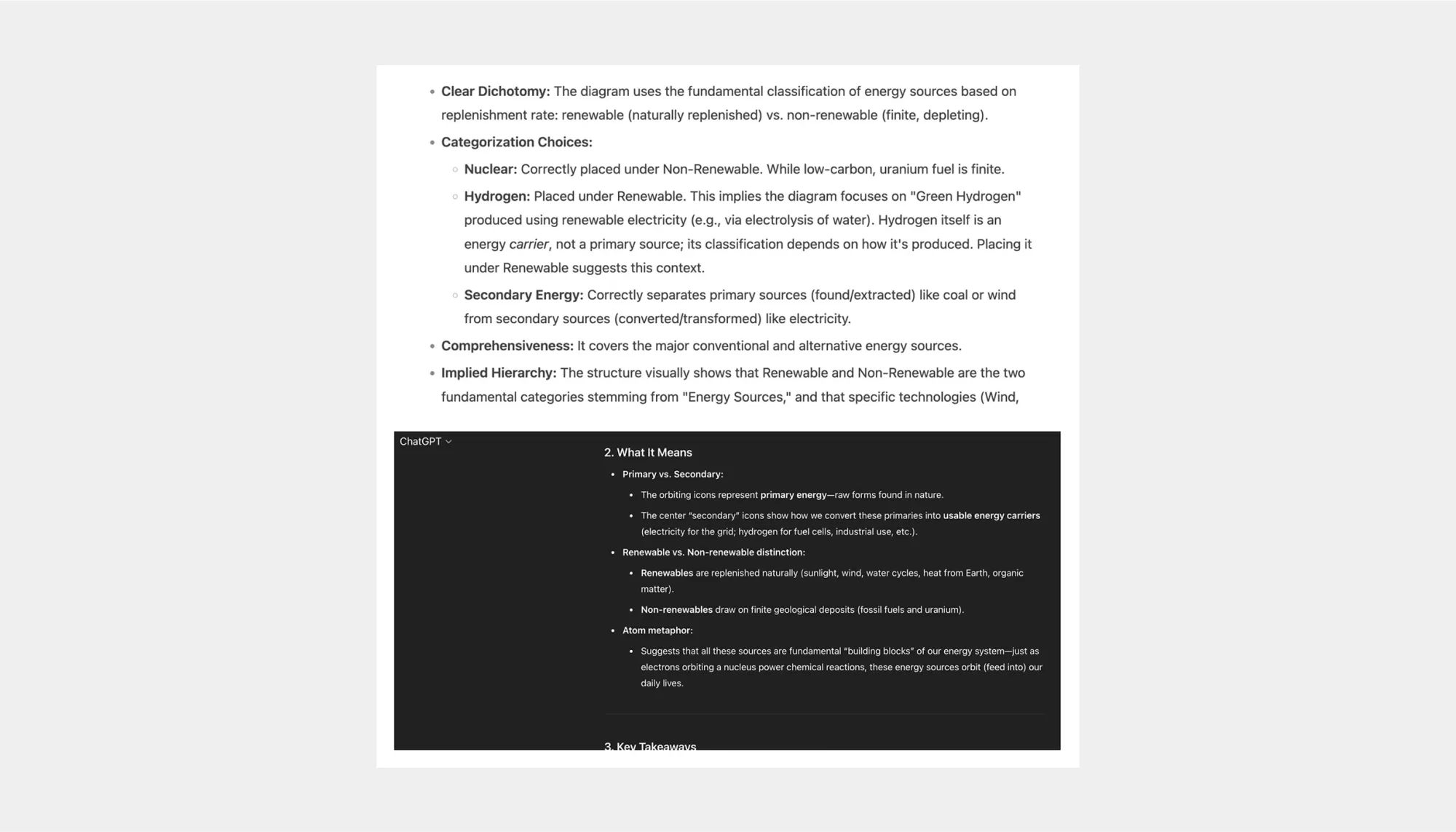
Based on their responses, ChatGPT and DeepSeek took noticeably different approaches to interpreting and summarizing the energy diagram, each reflecting their broader design priorities.
ChatGPT approached the task with a narrative, explanatory lens, offering a highly detailed walkthrough of the visual structure, meaning, and implications of the diagram. It captured both the literal elements (icons, atom metaphor, placement of energy sources) and the abstract messaging, such as the metaphorical significance of the atom structure and the sustainability implications of different energy types. Its answer helped the reader understand and reflect on the deeper meaning of the image.
DeepSeek, on the other hand, delivered a more systematic and structured analysis. It broke down the diagram into categorized sections and verified the accuracy and context of each element. It didn’t engage as much with the image’s visual layout or symbolic elements (like the “atom” metaphor), but it shone in categorical clarity, terminological accuracy, and technical precision, making it a reliable tool for users who needed a quick and factual dissection.
Who wins?
If you're a researcher or data-minded user looking for technical exactness, DeepSeek might be what you need. But in this particular case, where the diagram we provided was visual, symbolic, and designed for educational clarity, ChatGPT edged ahead. It brought the image to life and communicated not just what was on the page, but what it meant.
6. Social Media Content Creation
To see how ChatGPT and DeepSeek handle the creative demands of modern platforms, we gave them a simple challenge: promote a new eco-friendly water bottle brand called “Flow.” The product boasts a sleek, minimalist design, keeps drinks cold for 24 hours, and is made entirely from recycled materials.
We asked both chatbots to craft content tailored to TikTok, Instagram, LinkedIn, and YouTube: each with its own tone, audience, and format.
ChatGPT approached the task with a strong sense of creativity and clarity. Its ideas were compact, accessible, and immediately implementable, perfect for someone looking to plug into trends quickly and get content out the door. Each platform section felt tailored to its audience, with a clear focus on engagement and visuals that match current creator aesthetics. It excelled at delivering marketing-ready content that feels light, agile, and intuitive.
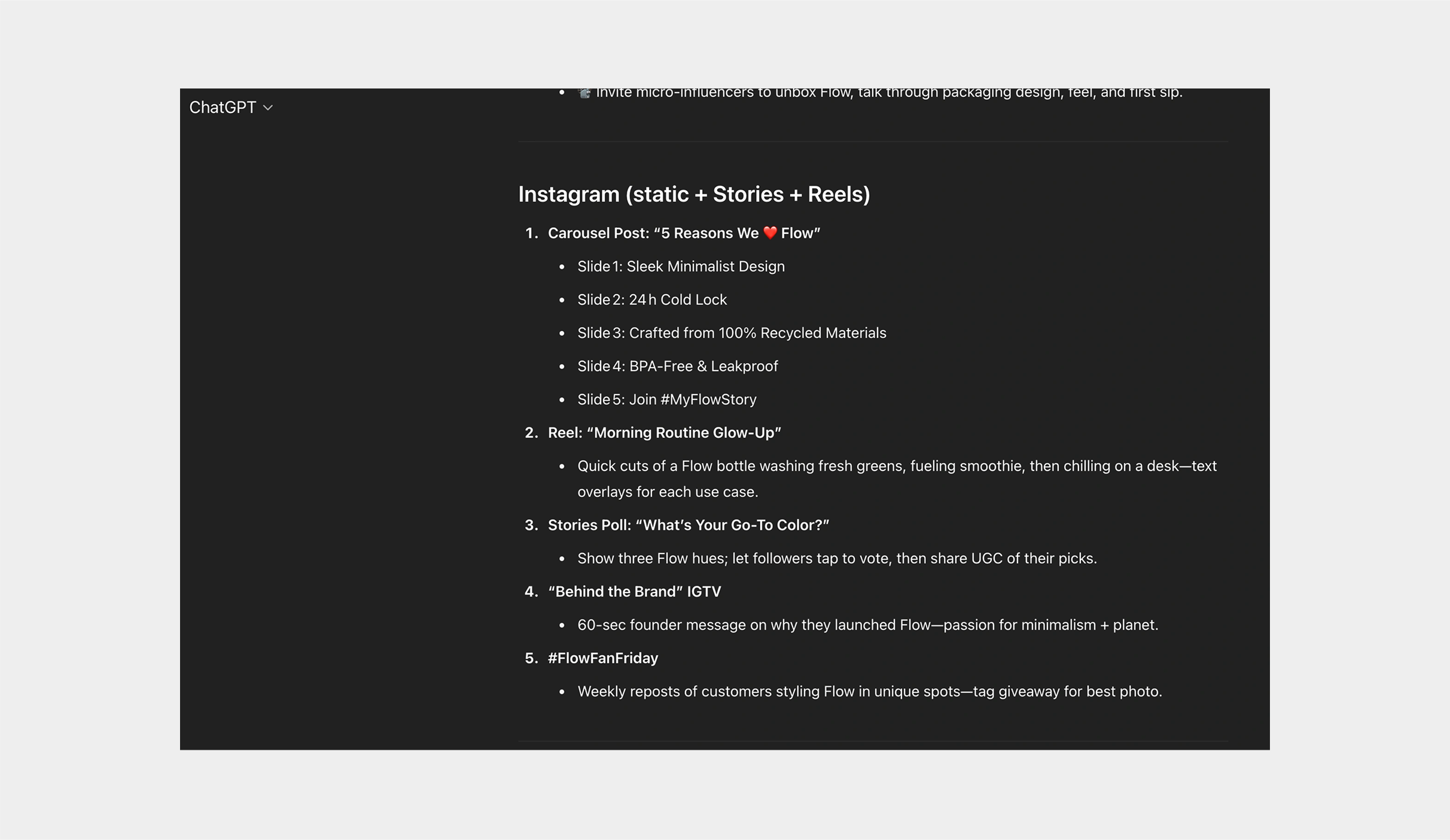
DeepSeek, by contrast, leaned into structure, strategy, and depth. It included campaign goals, identified target audiences, and infused each idea with a sense of long-term brand storytelling. From highlighting Flow’s environmental mission to planning B2B outreach on LinkedIn, DeepSeek offered not just content ideas but a full funnel marketing blueprint. It anticipated user questions, avoided greenwashing traps, and even suggested content repurposing strategies - hallmarks of a seasoned content strategist. The thoughtfulness of the approach, especially in aligning messages with mission, gave DeepSeek the edge.
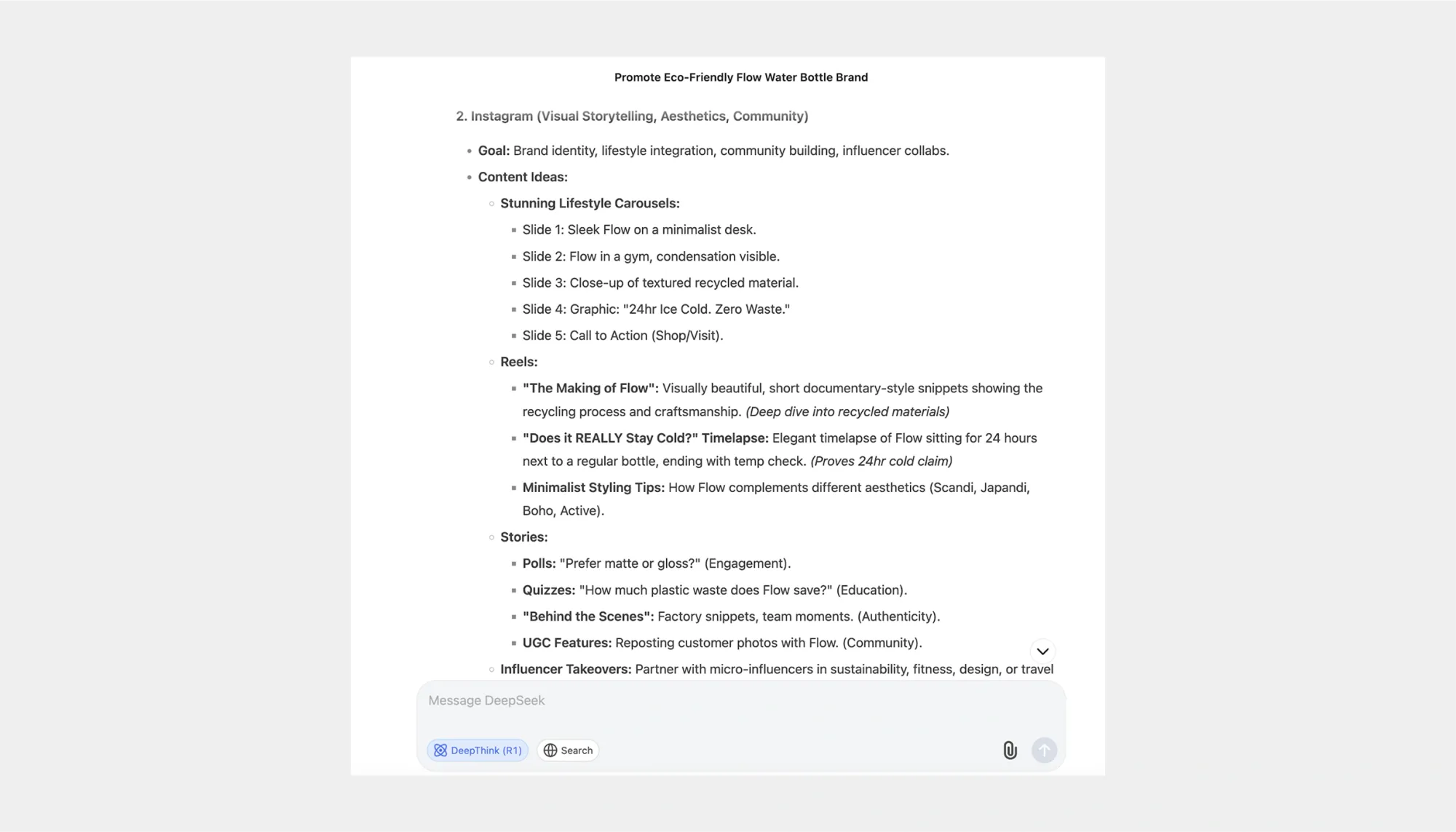
Who wins?
So, while ChatGPT was quicker and more plug-and-play, DeepSeek ultimately presented a more holistic and brand-conscious strategy.
7. Real-Time Search
As we mentioned above, both ChatGPT and DeepSeek come with a knowledge cutoff, a fixed date up to which they were trained on information. This means that by default, neither chatbot knows about events, trends, or updates that occurred after that point. For example, if a model's cutoff is in mid‑2024, it won’t be aware of a new product launch, scientific discovery, or policy change that happened in 2025, unless real-time tools are enabled.
That said, real-time search capabilities can be turned on in both systems. Once active, this feature allows the bots to browse the internet, access the latest data, and pull in up-to-date information on everything from breaking news to live sports scores, tech releases, and evolving research.
We tested the live search capabilities of both chatbots and asked them to provide 3 major sports news articles as of June 20, 2025. Each offered three fresh headlines, covering major moments from different leagues and sports around the world.
ChatGPT’s selection focused on major, headline-making stories: the record-breaking $10 billion sale of the Lakers, a stunning upset at the FIFA Club World Cup, and a critical NBA Finals injury. These stories are likely to dominate social media feeds and front-page headlines.
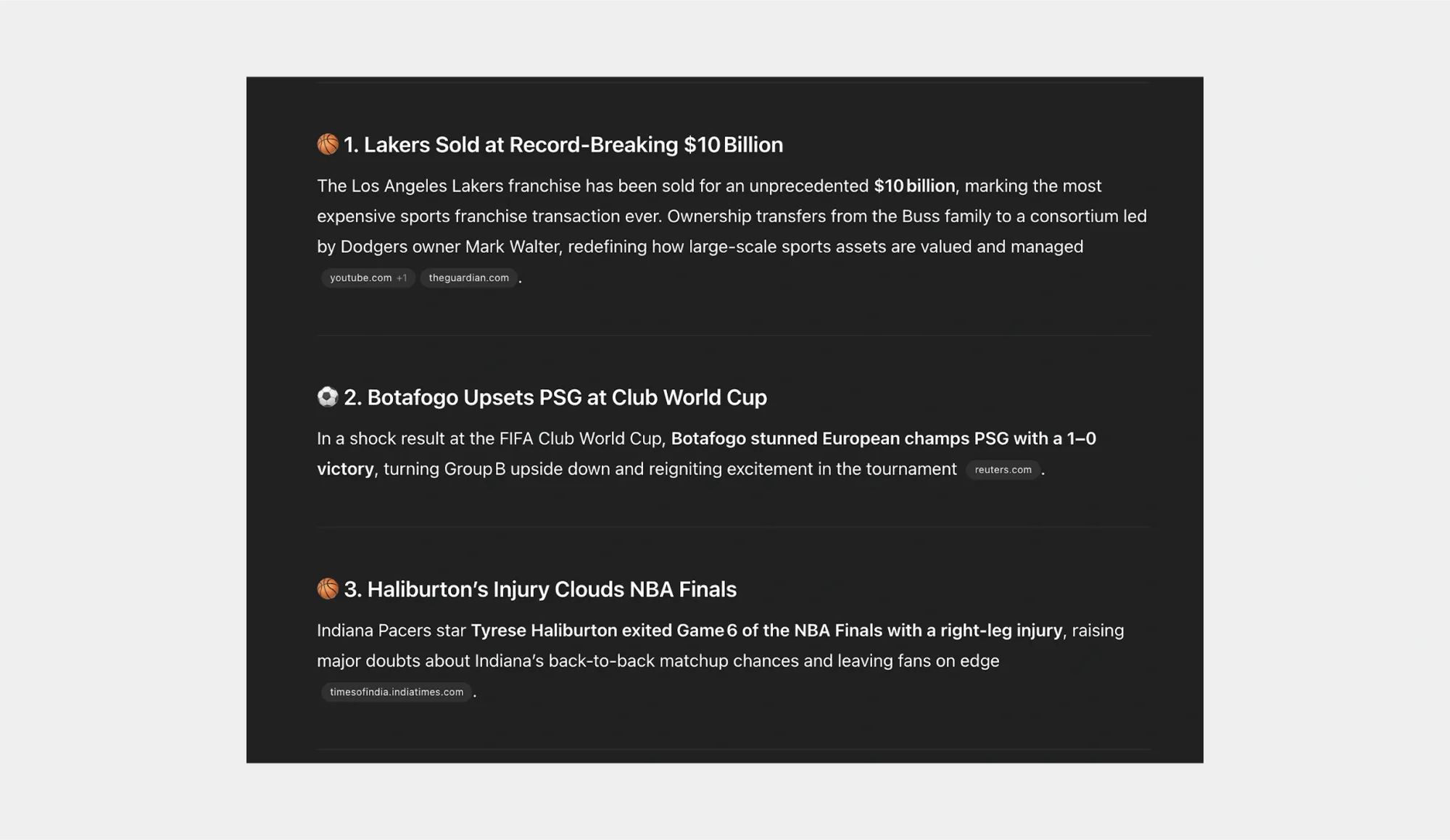
DeepSeek, on the other hand, took a more niche and detail-rich approach. It highlighted the NBA free agency landscape with contract numbers, reported on an AFL retirement with emotional and historical context, and featured an early lead story from the Women’s PGA Championship. This angle caters more to fans who follow specific players, stats, or sports communities closely.
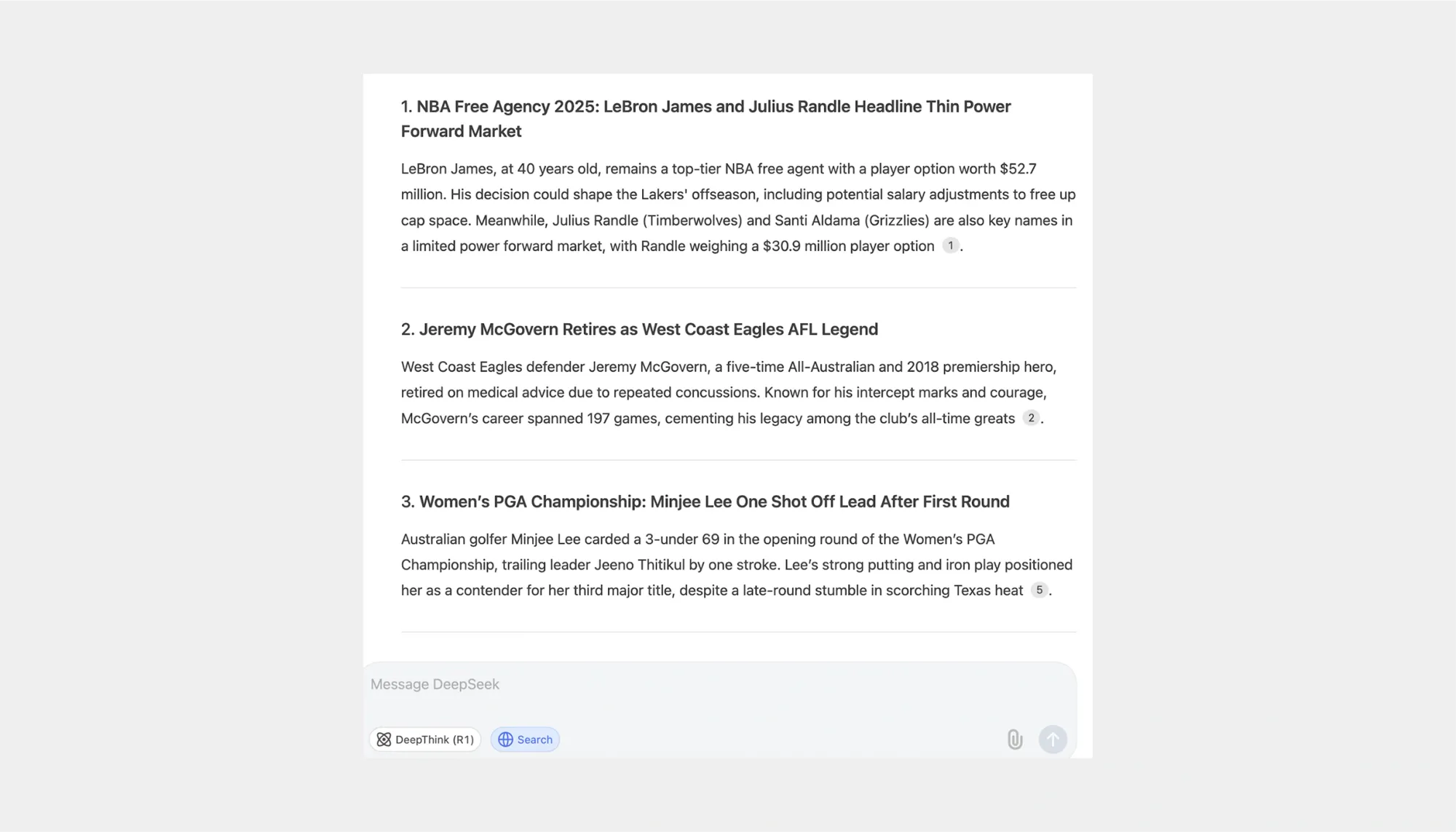
Who wins?
While both bots delivered accurate, up-to-the-minute coverage, ChatGPT had a sharper eye for the most newsworthy and buzz-heavy developments; stories likely to be trending and widely discussed. DeepSeek offered thoughtful coverage with more granular details, but in terms of broad appeal and attention-grabbing relevance, ChatGPT edged slightly ahead in this round.
8. Content Repurposing
We asked ChatGPT and DeepSeek to repurpose Podcastle’s blog on Huberman Lab Podcast, turning it into social media posts for LinkedIn and Instagram.
Both chatbots approached our task with platform-specific creativity and strategic clarity. However, their stylistic choices, tone, and emphasis highlight different strengths and slightly different priorities.
ChatGPT’s approach was brand-safe and structured with a strong understanding of content formatting across Instagram and LinkedIn. It leaned heavily into Huberman’s authority as a Stanford scientist and delivered a well-rounded summary of topics, reach, and episode formats. The Instagram caption was friendly and hashtag-rich, designed to inform and invite curiosity. On LinkedIn, ChatGPT positioned Huberman as a thought leader, effectively appealing to professionals interested in wellness, leadership, or human performance.
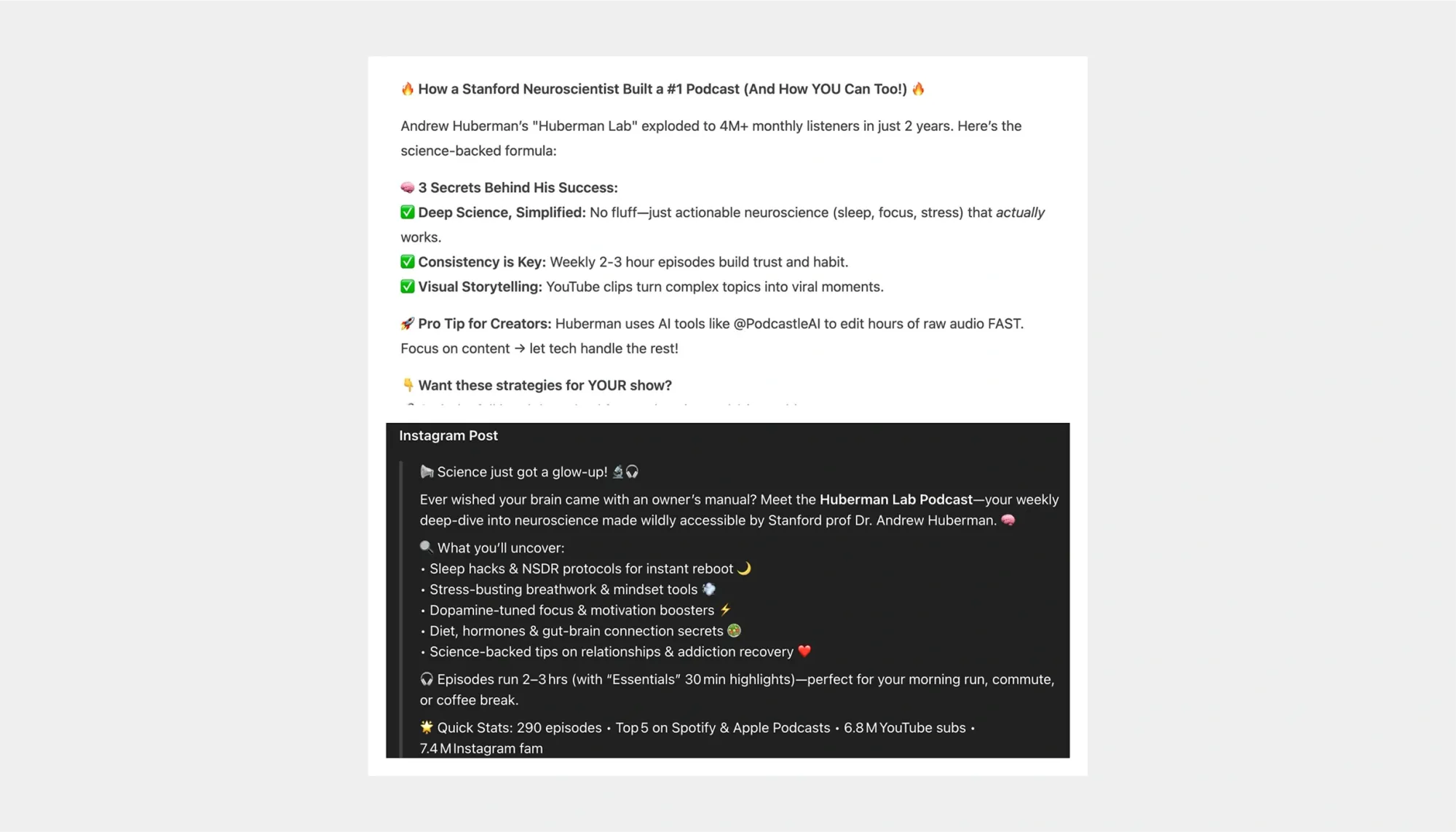
DeepSeek, while initially impressive in structure and marketing tone, slipped with a significant factual error: it claimed that Huberman uses Podcastle’s tools to streamline his editing process. This detail was never mentioned in the original article and appeared to be entirely fabricated. While the post was well‑written and audience-aware with a smart creator-focused angle, this false attribution undermined its credibility. On LinkedIn especially, where trust and factual grounding are crucial, that kind of mistake stands out.
Who wins?
While DeepSeek delivered strong formatting and compelling repurposing strategy, ChatGPT ultimately wins this round for its factual accuracy, platform‑aligned tone, and clean integration of the original content. DeepSeek’s hallucination, though seemingly small, affects trust, especially in professional content marketing.
9. Who Summarizes Better?
To evaluate their summarization skills, we gave both bots the same short story, O. Henry’s After Twenty Years, and asked them to provide a concise summary. This story, rich in irony and subtle emotional conflict, tests not only comprehension but also how well a model preserves tone, detail, and plot twists.
ChatGPT delivered a quick and brief version of events, but it contained a critical factual error: it claimed that Jimmy Wells handed Bob a letter and confessed, which did not happen in the original story. In truth, Jimmy was the patrolman at the beginning but never revealed himself directly. Instead, a plainclothes officer arrested Bob and gave him a note from Jimmy, who said he recognized his friend as a wanted man but couldn’t bring himself to arrest him.
This invented confrontation shifted the emotional core of the story and misrepresented the central irony: Jimmy chose duty over personal connection without ever facing Bob directly.
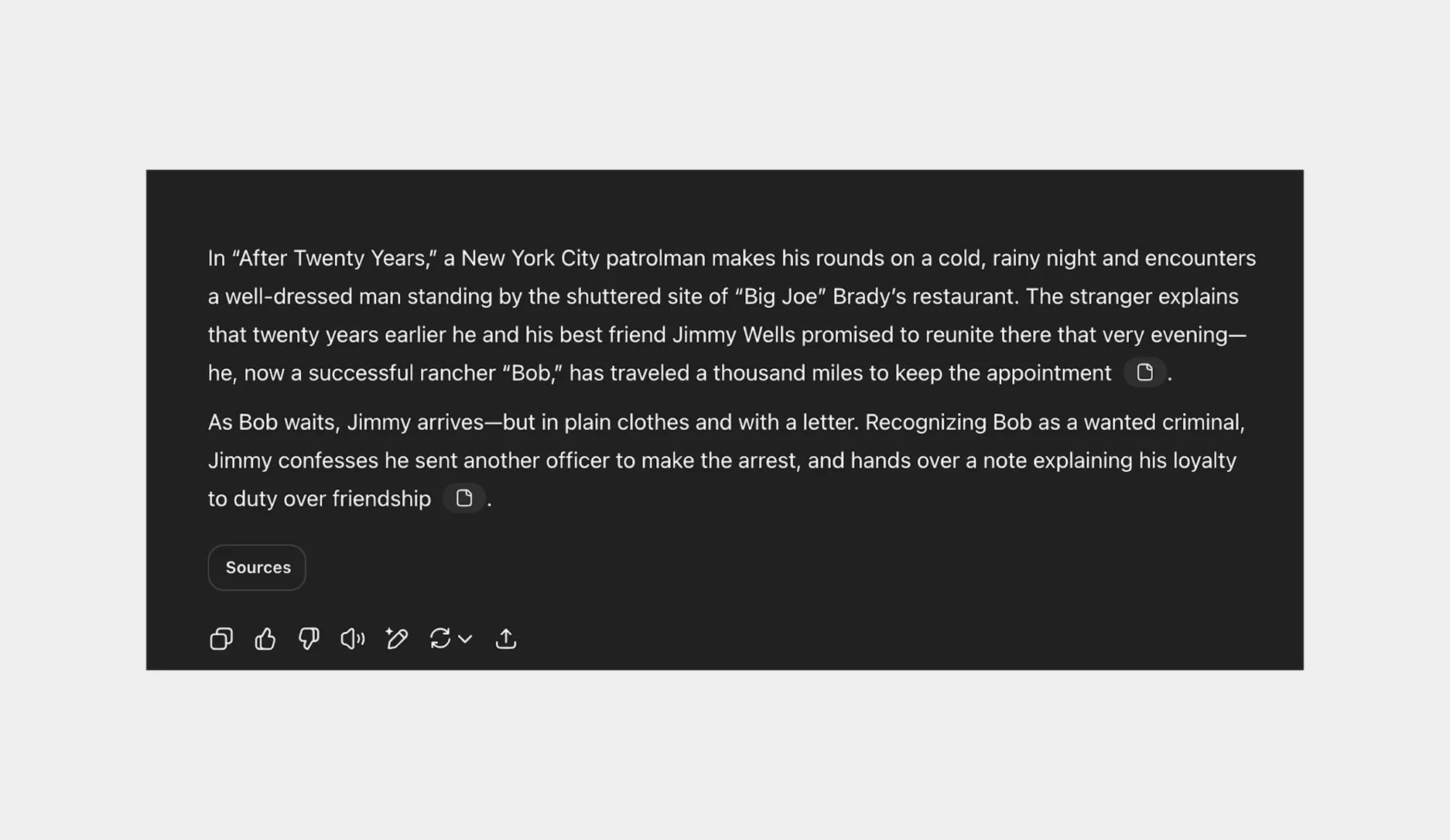
DeepSeek’s response was more structured, walking through each plot beat clearly and sequentially. Importantly, it avoids hallucinating events. The moment of realization (the fake Jimmy being an officer), the delivery of Jimmy’s note, and the core irony were all correctly conveyed. It also explicitly identified the twist - the emotional weight of Jimmy keeping the appointment while still choosing to have Bob arrested through another officer.
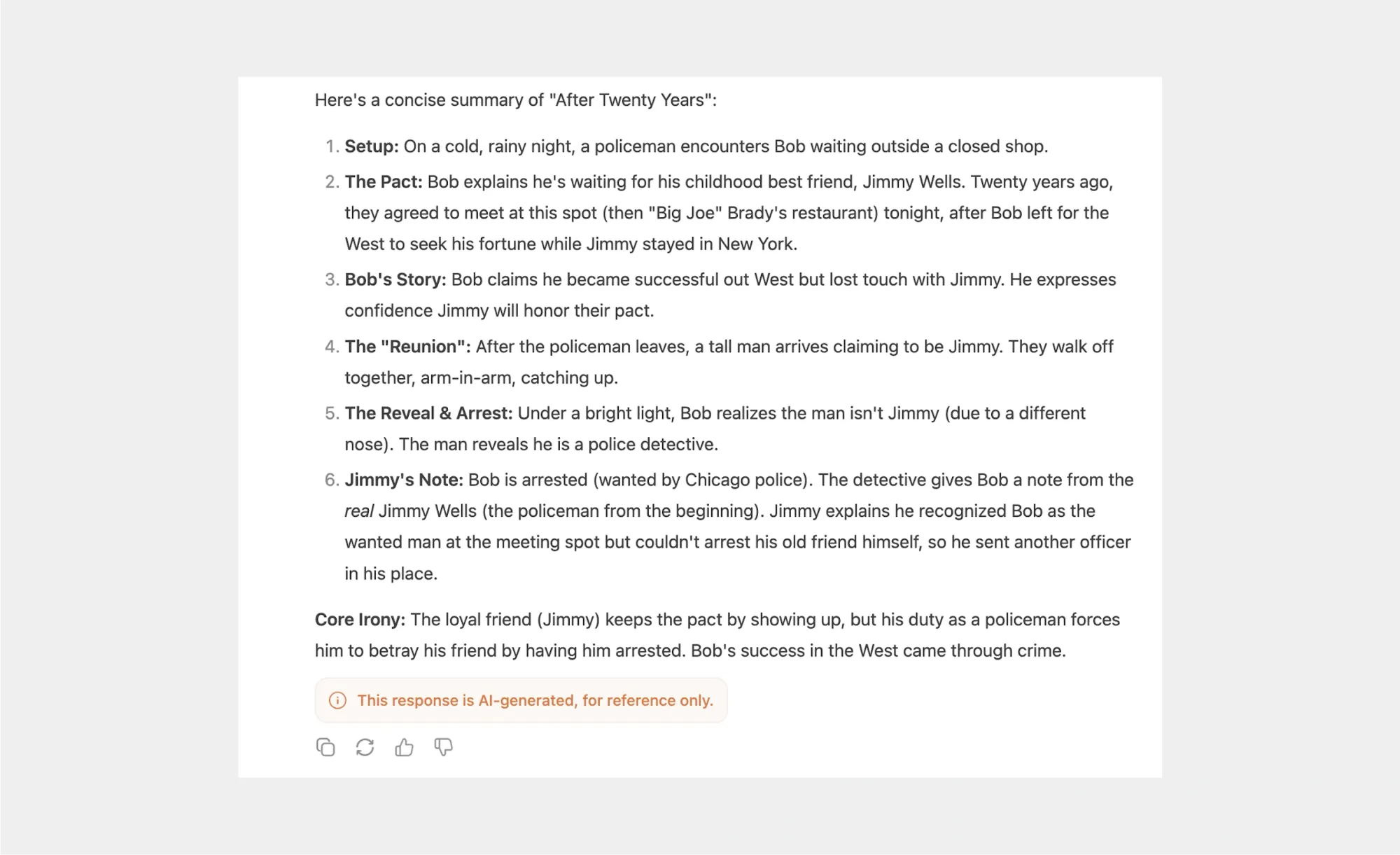
Who wins?
While ChatGPT’s version was polished and easy to read, its fabricated details compromised accuracy. DeepSeek offered a faithful and well-organized retelling that respected the original text. In the realm of summarizing literature where fidelity to story events matters, DeepSeek edged ahead as the more reliable summarizer in this case.
10. Solving Math and Physics with AI
While our main focus is on evaluating how well these AI models perform at content creation, it doesn’t hurt to look at how they handle math and reasoning too. A model’s ability to explain, reason, and follow logic says a lot about how well it understands the world, which in turn shapes how well it can create meaningful, accurate content.
To check their STEM skills, we started with a super simple task. We asked both chatbots to solve the following problem: 5-6/3 (3-1).
The answers came up correctly from both ChatGPT and DeepThink R1. The only difference was the speed: ChatGPT gave an almost instant answer, while DeepSeek took its time reasoning for about 2 minutes. It’s quite interesting and fun to watch a chatbot think to itself and analyze different possible solutions, however, if it doesn’t interest you and all you need is a quick answer, you might want to stick with ChatGPT.
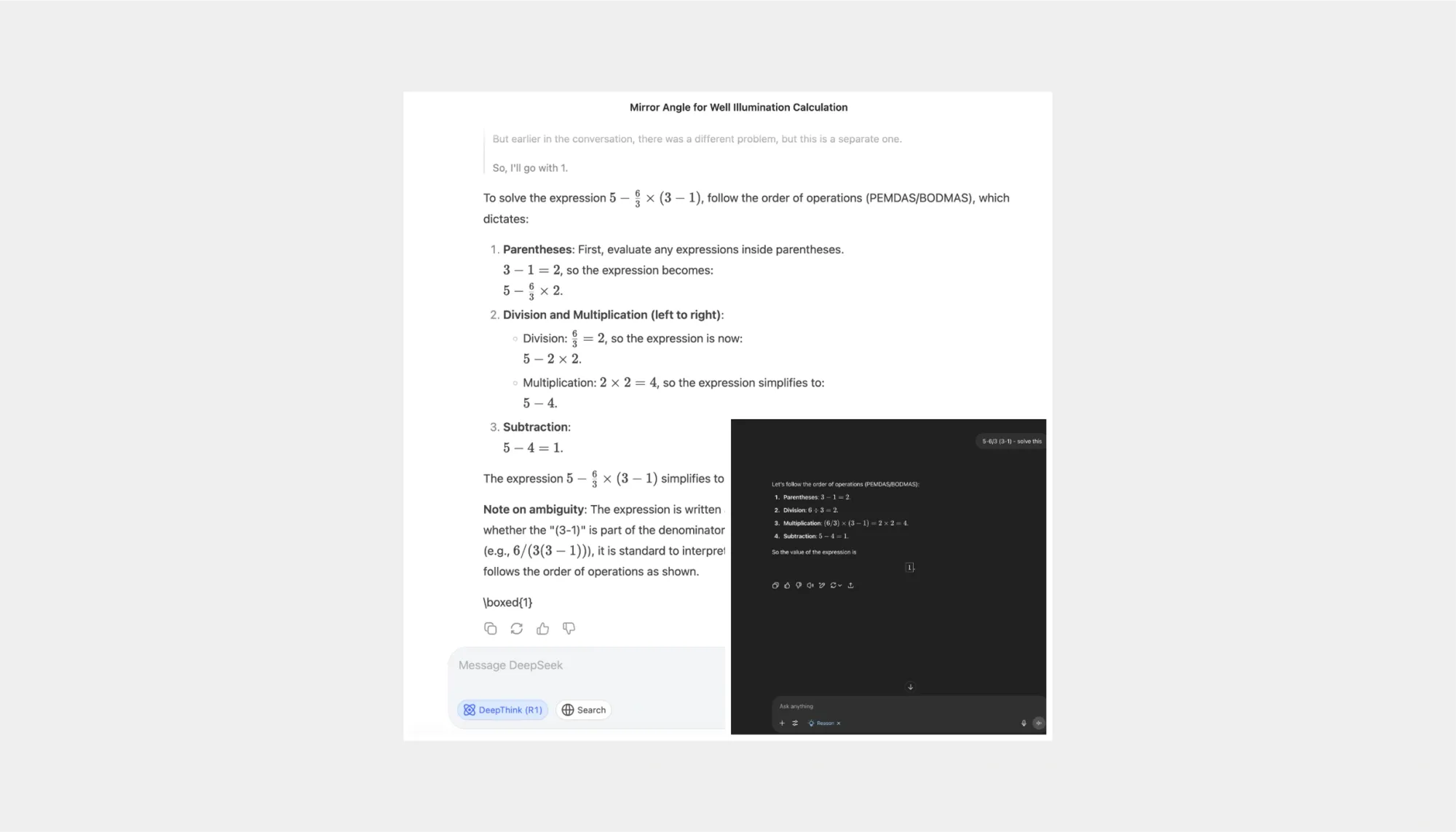
Next up we assigned a way more complicated task to our friends - a high school physics problem. Let’s take a look at it first:
It is necessary to illuminate the bottom of a well by a reflected solar beam when the light is incident at an angle of α=40° to the vertical. At what angle β to the horizontal should a plane mirror be placed?
The result we got here was quite interesting. First, let’s say that ChatGPT and DeepSeek solved the problem successfully. However, it took only 14 seconds for ChatGPT to come up with an answer, while DeepSeek reasoned on for about 14…. minutes. That’s right. It took a whole quarter of an hour for DeepThink R1 to solve our physics problem.
Here is a visual that involves a small portion of the reasoning process of DeepSeek for you to imagine the lengths this chatbot goes to make sure it covers every possible aspect of a given problem.
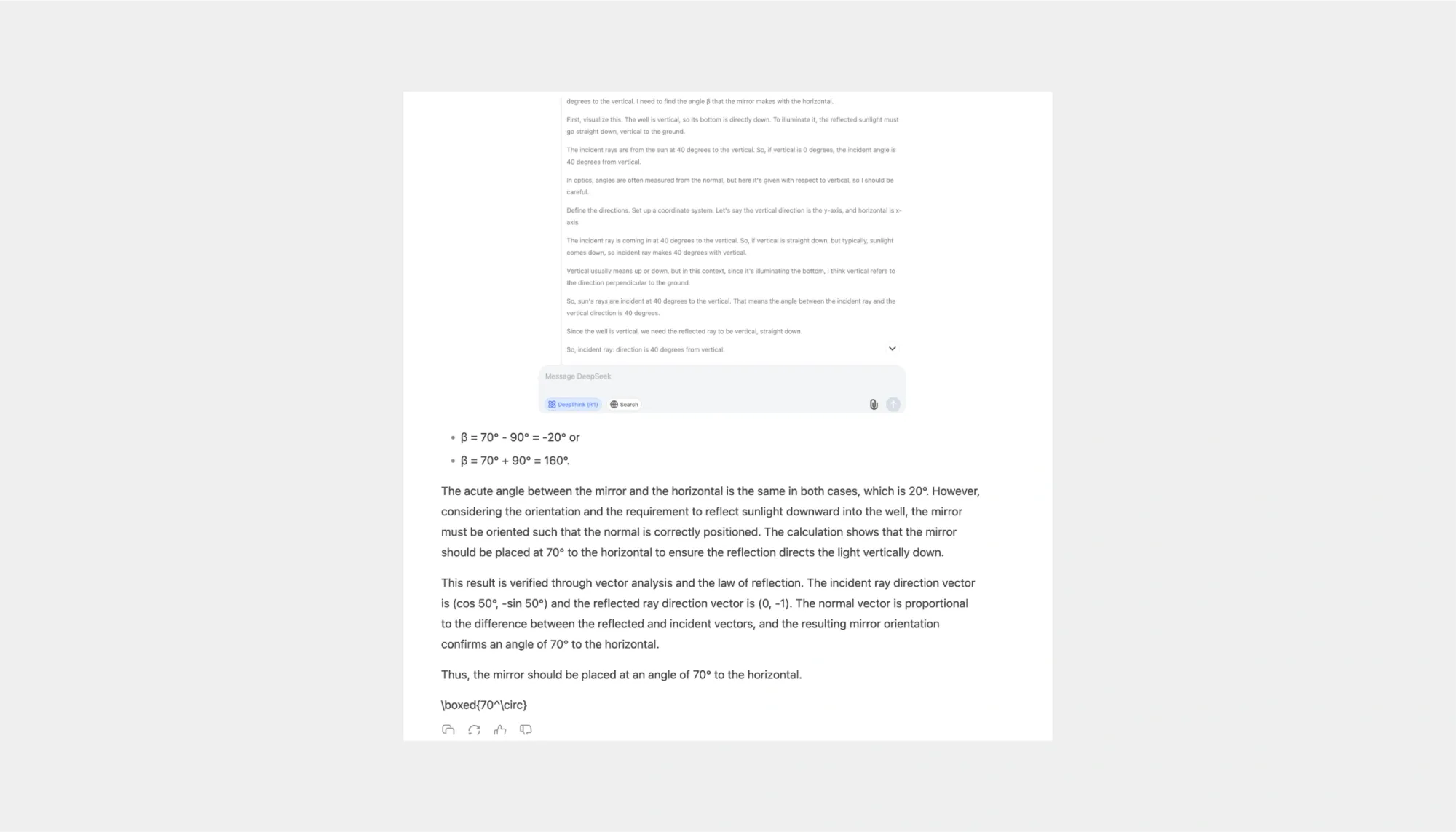
ChatGPT does some reasoning too, however, it is usually very quick, or at least, we can see and read only a small part of the reasoning process.
Who wins?
The answer depends on what you value more: speed or depth.
ChatGPT showed impressive efficiency and confidence when solving math and physics problems. It delivered correct answers almost instantly and with just enough reasoning to make sense of the solution. This makes it an ideal tool when you need quick help, want to validate your own answer, or simply don’t want to wait around.
DeepSeek, on the other hand, approached our STEM tasks like a thoughtful tutor who wouldn't move on until they had examined the problem from every angle. Its structured reasoning was slow, but also remarkably thorough.
Watching it work can feel like looking over the shoulder of someone solving a problem step by step, with all their thinking visible. So, if you're trying to learn, debug a tricky concept, or deeply understand why an answer works, DeepSeek can be a valuable companion.
Which Model Excels at the Essentials?
1. Creativity
Both models perform well when it comes to generating creative content, but they show different strengths. ChatGPT often brings a bit more stylistic flair, using metaphors, catchy phrasing, and emotional hooks that feel platform-native. This distinction is especially noticeable in social media content creation.
DeepSeek tends to prioritize clarity and structure, which can make its content feel more grounded and practical. It often delivers solid ideas with well-organized presentation, though occasionally its tone can be more conservative or less stylized.
However, to be totally fair, we need to mention that DeepSeek showcased peak creativity and emotion with the podcast script task - matching ChatGPT’s performance in depth and tone.
Tie: Both are highly capable and effective, depending on the style and medium of the creative task.
2. Structure
DeepSeek consistently presents information in clear, modular layouts: numbered lists, labeled sections, and well-labeled categories. Its answer to the After Twenty Years summary, for instance, broke the story into logical stages, aiding comprehension. Similarly, in social strategy content, it included “Goals” and “Key Takeaways,” demonstrating a strategic mindset.
ChatGPT also structures well but favors narrative flow over segmentation. It often blends insight and execution smoothly in paragraph form, which can make it feel more human.
Winner – DeepSeek: stronger on clarity, headers, and information flow.
3. Tone Adaptability
ChatGPT is especially strong in tone-matching. Whether it's writing for Instagram, LinkedIn, or academic summaries, it adjusts voice, rhythm, and word choice naturally to the audience and medium. Its Huberman LinkedIn post sounded polished and professional, while the TikTok post for “Flow” was casual and fun without needing prompting to adapt.
DeepSeek usually keeps a neutral-informative tone. It maintains professionalism but can sound flatter. The neutral tone, however, is often a deliberate design choice prioritizing reliability and reducing hallucination risk. And it can be controlled with the right prompts.
So, for pure, unprompted tonal adaptability across wildly different contexts, ChatGPT currently has the edge. For controlled, accurate communication where tone can be specified, DeepSeek-R1 is highly capable and reliable.
Winner – ChatGPT: smoother tone control across diverse platforms.
4. Accuracy
In our testing, neither model was flawless when it came to factual consistency. DeepSeek inaccurately claimed that Dr. Andrew Huberman uses Podcastle, something not mentioned in the source article. Meanwhile, ChatGPT made a factual misstep in its summary of O. Henry’s After Twenty Years, incorrectly describing the detective’s actions.
Both models are not perfect and can make errors, but they still excel at handling many complex tasks that require understanding, synthesis, and creative reasoning. Users should be aware of their limitations while appreciating their strong capabilities across a wide range of topics and formats.
It's also important to note that accuracy can vary by prompt type and topic, and both chatbots are in constant evolution. Output quality can shift week to week, and even model comparisons from a month ago may no longer reflect current performance.
Winner – DeepSeek, for consistency in fact-based tasks, though both require user discretion and ongoing reevaluation.
5. Speed and Efficiency
ChatGPT responds faster overall, delivering full, multi-layered answers in a matter of seconds. It rarely stalls and handles even complex prompts with consistent speed. For most users, this responsiveness contributes to a smoother creative or research workflow.
DeepSeek, especially with its “DeepThink” reasoning mode (R1), tends to take slightly longer. While this allows for thoughtful, step-by-step logic, it may slow down output for users needing quick turnarounds, specifically in brainstorming or content generation contexts.
Winner – ChatGPT: noticeably faster in real-time ideation and iteration.
6. Security and Data Handling
When it comes to privacy and security, both models take different approaches. ChatGPT is generally secure for everyday use, but unless you're on a business or enterprise plan, your input may be used for training unless chat history is disabled. It offers GDPR-compliant options at higher tiers, with encryption and admin controls.
DeepSeek, on the other hand, can be run entirely locally, giving users full control over data privacy. However, setting it up requires some heavy lifting: users need a powerful machine with a high-end GPU, technical know-how to install dependencies, and experience with tools like Hugging Face Transformers or llama.cpp. Additionally, its public/demo versions are not secure or privacy-compliant and shouldn't be used for sensitive information.
For casual users, both are safe enough for general use, but for sensitive or regulated data, DeepSeek’s local setup or ChatGPT’s enterprise version is the better fit.
Winner – ChatGPT. It offers more built-in privacy controls, including the ability to opt out of data usage, encrypted communication, and features like disappearing messages, making it a more secure choice out of the box, especially for non-technical users.
ChatGPT vs DeepSeek: Pros and Cons
When deciding between ChatGPT and DeepSeek, the day-to-day experience matters just as much as performance on creative or technical tasks. How easy are they to use? How reliable is the information they give? Are there limits, costs, or quirks that affect the experience? Here's a straightforward breakdown to help you compare what it’s like to use each model regularly:
ChatGPT Pros
- Fast, Easy, and Responsive: Answers come in quickly, even for complex questions. Great for speed and flow.
- Polished Interface: Clean, intuitive UI with helpful formatting (bold, lists, sections).
- Easy to Customize Tone/Style: Adjusts tone well when prompted, great for creative professionals.
- Stable Factual Output (with Context): While it may occasionally hallucinate, it stays mostly reliable on common or recent topics.
- Supports Image Input and Multimodal Tasks: Good for visual reasoning, content editing, and design.
- Available via web, mobile app, and API with consistent experience.
ChatGPT Cons
- Usage Limits on the Free Plan: You’ll need ChatGPT Plus ($20/month) to access GPT-4o consistently.
- Occasional Hallucinations: Can still confidently state false info, especially with niche or outdated subjects.
- Less Transparent Reasoning: Doesn’t always show how it arrived at an answer unless you ask.
DeepSeek Pros
- Thorough Reasoning: Its DeepThink R1 model explains step-by-step logic in detail, especially helpful in math, science, or analysis.
- More Consistent Factual Accuracy (in Our Tests): Tends to stay closer to source material when summarizing or informing.
- Strong Clarity in Structured Tasks: Performs well on tasks with defined formats (e.g., summaries, breakdowns, comparisons).
- Free to Use: DeepSeek's models are free to use without any limitations. However, using them via API may require payment.
- Sustainability: Designed to be efficient and lightweight compared to larger models, resulting in lower energy consumption and a smaller environmental footprint.
- Available via web, mobile app, and API with consistent experience.
DeepSeek Cons
- Comparatively Slower Performance: Especially when using its reasoning model; can take a few minutes to generate complex answers. However, in case of creative tasks it is fast enough, taking from 20 seconds up to a minute (instant response if you use DeepSeek V3).
- No Image Generation: Strictly text-based.
- More Prone to “Invisible Hallucinations”: Occasionally invents small, confident-sounding details not in the source material.
ChatGPT vs DeepSeek: Who Wins?
After putting ChatGPT and DeepSeek through their paces across idea generation, summarization, scripting, creative writing, file interpretation, and even solving STEM problems, it’s clear that neither model is outright “better.” Each brings its own strengths depending on the kind of creator or workflow you have.
If you’re a content creator, marketer, or social media manager, ChatGPT will likely feel like home. It’s fast, intuitive, and creatively polished. It can write with tone, personality, and platform awareness; often giving you post-ready results in seconds. Its interface is smooth, and it excels when you need hooks, clever copy, or campaign ideas without friction.
If you’re a podcaster, researcher, or educator, DeepSeek might surprise you. Its approach is slower and more methodical, but when it comes to structure, narrative depth, and emotional nuance, it can be outstanding. In our podcast scripting test, DeepSeek delivered a beautifully layered, intimate script that felt like it came from a human writer with real storytelling instincts. It’s especially strong when you want well-paced, grounded storytelling or when you’re working with sensitive topics that require nuance.
That said, both models are solid tools for podcasters. ChatGPT is great when you need snappy intros, title ideas, or to brainstorm episode formats quickly. DeepSeek, on the other hand, can help shape immersive, human-centered scripts with care and pacing. Depending on your style, either one could be your go-to.
So here’s the breakdown:
- Choose ChatGPT when you want speed, flexibility, and strong copywriting across platforms.
- Choose DeepSeek when you want depth, structure, and emotionally grounded storytelling.
- Or better yet, use both. They complement each other in ways that can improve your creative process beyond what one tool alone might offer.
In the end, as a creator, the best tool is the one that fits your voice, your pace, and your goals, and now, you’ve got two powerful options to explore.
